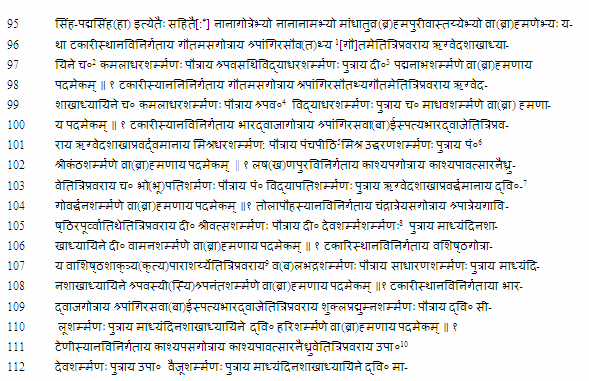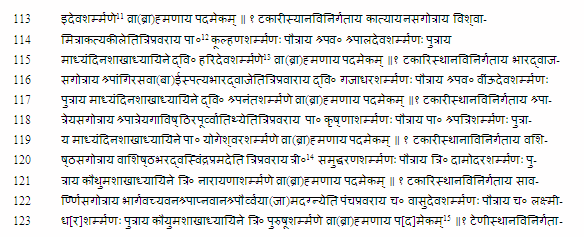| |
North
Indian Inscriptions |
| |
|
|
|
INSCRIPTIONS OF THE PARAMARAS OF MALWA
MĀNDHĀTĀ COPPER-PLATE INSCRIPTION OF THE TIME OF JAYAVARMAN

Fourth Plate : First Side
 __________________________________________________________________
[1] Sandhis have not been observed in most of the following cases, while giving the details about the donees. It is not pointed out or corrected every time.
[2] Read chāturvēda- or charturvēdi-, here and below.
[3] Read dīkshita-, here and below.
[4] Read avasathika-, here and below.
[5] Sircar observes that pañchapāṭhin is probably intended.
[6] That is Pañchapāthin, Paṇḍita, or Pañchōlī-.
[7] That is, dvivēda- or dvivēdi-, here and below.
[8] The suffix śarman appears twice with this name and also in 1. 110, below.
[9] Here all the three pravaras are shown with the first of the letters in its form of vṛiddhi.
[10] Dr. Sircar observed that this is probably a contraction of upāsani, but upādhyāya is also possible.
[11] Sircar read the second letter of the name as hā but it is a clear i, in the impression and on the plate also.
[12] Read pāṭhaka-, here and below. The akshara was first engraved before this letter and later on उ erased but the sign is still visible.
[13] The curve of the medial i of रि was either cut by the hole on the plate or was not engraved as it comes precisely at that spot.
[14] That is, Trivēda- and Trivēdi-, here and elsewhere.
[15] Originally पा was engraved and the sign for the medial ā was later on erased but it is still visible.
|
\D7
![]()
|









